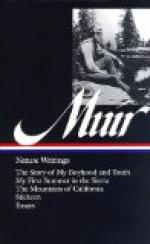By this time I had learned to run the breaking plough. Most of these ploughs were very large, turning furrows from eighteen inches to two feet wide, and were drawn by four or five yoke of oxen. They were used only for the first ploughing, in breaking up the wild sod woven into a tough mass, chiefly by the cordlike roots of perennial grasses, reinforced by the tap-roots of oak and hickory bushes, called “grubs,” some of which were more than a century old and four or five inches in diameter. In the hardest ploughing on the most difficult ground, the grubs were said to be as thick as the hair on a dog’s back. If in good trim, the plough cut through and turned over these grubs as if the century-old wood were soft like the flesh of carrots and turnips; but if not in good trim the grubs promptly tossed the plough out of the ground. A stout Highland Scot, our neighbor, whose plough was in bad order and who did not know how to trim it, was vainly trying to keep it in the ground by main strength, while his son, who was driving and merrily whipping up the cattle, would cry encouragingly, “Haud her in, fayther! Haud her in!”
“But hoo i’ the deil can I haud her in when she’ll no stop in?” his perspiring father would reply, gasping for breath between each word. On the contrary, with the share and coulter sharp and nicely adjusted, the plough, instead of shying at every grub and jumping out, ran straight ahead without need of steering or holding, and gripped the ground so firmly that it could hardly be thrown out at the end of the furrow.
Our breaker turned a furrow two feet wide, and on our best land, where the sod was toughest, held so firm a grip that at the end of the field my brother, who was driving the oxen, had to come to my assistance in throwing it over on its side to be drawn around the end of the landing; and it was all I could do to set it up again. But I learned to keep that plough in such trim that after I got started on a new furrow I used to ride on the crossbar between the handles with my feet resting comfortably on the beam, without having to steady or steer it in any way on the whole length of the field, unless we had to go round a stump, for it sawed through the biggest grubs without flinching.
The growth of these grubs was interesting to me. When an acorn or hickory-nut had sent up its first season’s sprout, a few inches long, it was burned off in the autumn grass fires; but the root continued to hold on to life, formed a callus over the wound and sent up one or more shoots the next spring. Next autumn these new shoots were burned off, but the root and calloused head, about level with the surface of the ground, continued to grow and send up more new shoots; and so on, almost every year until very old, probably far more than a century, while the tops, which would naturally have become tall broad-headed trees, were only mere sprouts seldom more than two years old. Thus the ground was kept open like a prairie, with only five or six trees to the acre, which had escaped the fire by having the good fortune to grow on a bare spot at the door of a fox or badger den, or between straggling grass-tufts wide apart on the poorest sandy soil.




